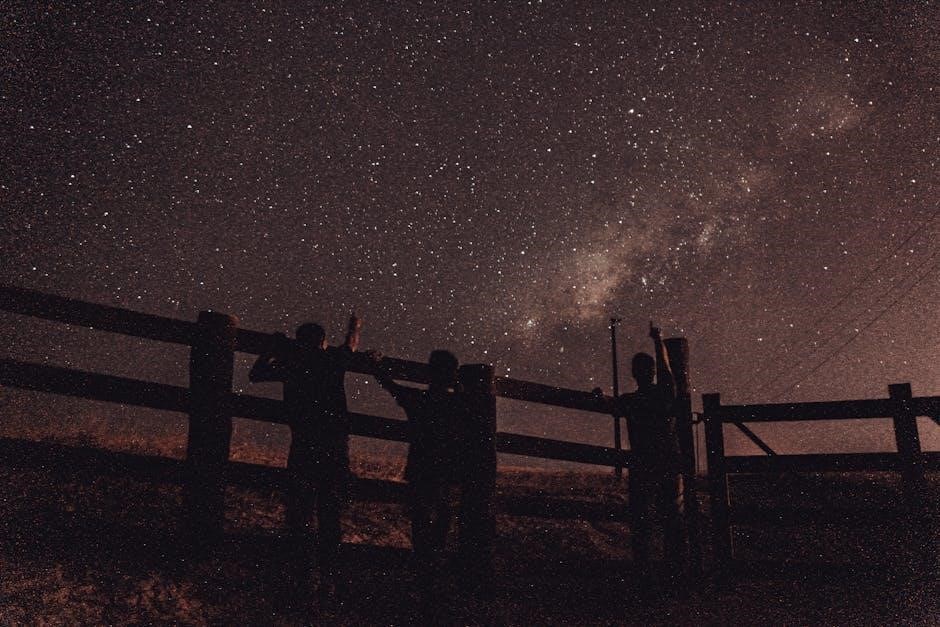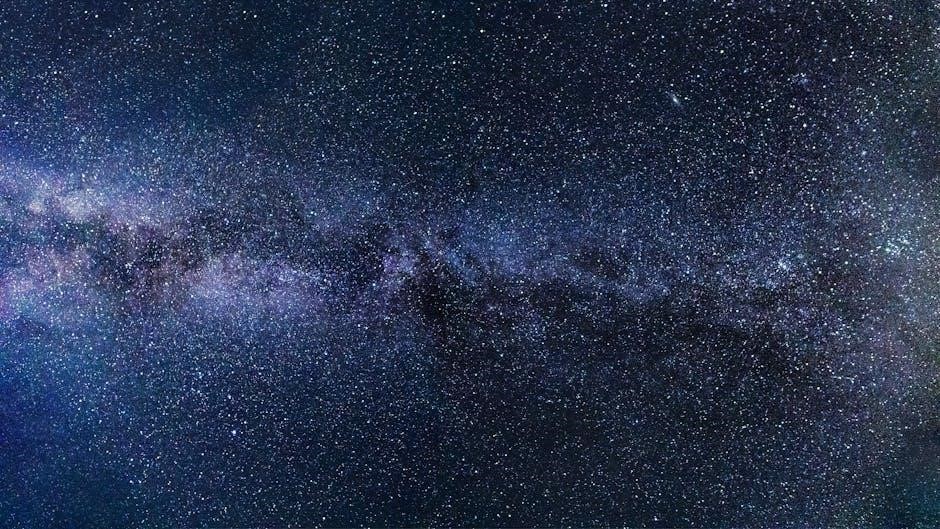The Hitchhiker’s Guide to the Galaxy is a cult classic comedy science fiction novel by Douglas Adams, first published in 1979. It blends humor, satire, and existential themes, following the misadventures of Arthur Dent as Earth is demolished. The book is the first in a series of five, exploring the absurdities of life, the universe, and everything in between.
Overview
The Hitchhiker’s Guide to the Galaxy is a groundbreaking comedy science fiction novel by Douglas Adams, first published in 1979. It follows the misadventures of Arthur Dent, an unwitting human survivor, as Earth is demolished to make way for a galactic freeway. Rescued by his friend Ford Prefect, an alien researcher for the titular guide, Arthur embarks on a journey through space. The novel humorously explores themes of existentialism, technology, and the absurdity of life, blending satire with imaginative storytelling. Its unique voice and wit have made it a cult classic, resonating with readers and inspiring numerous adaptations across media.
Background of Douglas Adams
Douglas Adams was a British author, born in 1952, known for his witty humor and creative storytelling. His career began in radio and TV before writing The Hitchhiker’s Guide to the Galaxy, which catapulted him to fame. His unique blend of comedy and science fiction left a lasting impact on pop culture and literature.
Early Life and Career
Douglas Adams was born on March 11, 1952, in Cambridge, England. He developed a passion for writing at an early age, despite struggling with dyslexia in school. Adams studied English Literature at St. John’s College, Cambridge, where he also joined the Footlights Drama Society, nurturing his comedic talents. After university, he worked as a bodyguard, a hotel porter, and a BBC radio producer before gaining recognition as a writer. His early career included contributions to shows like Doctor Who and The Hitchhiker’s Guide to the Galaxy, which began as a radio series in 1978. His unique humor and creativity laid the groundwork for his iconic novel.

The First Edition
The first edition of The Hitchhiker’s Guide to the Galaxy was published in 1979 by Pan Books in paperback, quickly becoming a bestseller. Its unique humor and creativity captivated readers, leading to further editions and adaptations.
Publishing Details
The first edition of The Hitchhiker’s Guide to the Galaxy was published in October 1979 by Pan Books in the United Kingdom. It was released in paperback format, priced at £1.95, making it accessible to a wide audience. The book was an instant success, selling over 250,000 copies within its first three months. The initial print run was modest, but due to its popularity, multiple reprints were issued. The cover design featured a distinctive logo of the Hitchhiker’s Guide, which became iconic. Pan Books’ decision to publish the novel in paperback first helped it reach a broader readership, contributing to its cult status.
Key Features
The first edition of The Hitchhiker’s Guide to the Galaxy is renowned for its unique blend of humor, absurdity, and science fiction. It introduces the iconic guidebook, which serves as a fictional handbook for intergalactic travelers. The novel’s narrative is filled with clever wordplay, satirical commentary, and existential themes. One of its standout features is the concept of the supercomputer Deep Thought, which calculates the “Answer to the Ultimate Question of Life, the Universe, and Everything” as 42. The book also introduces memorable characters like Marvin the Paranoid Android and the Heart of Gold spaceship. Its unpredictable storytelling and irreverent style captivated readers, making it a groundbreaking work in comedic science fiction.

Plot Summary
Arthur Dent escapes Earth’s demolition with Ford Prefect, an alien researcher. They journey through space, aided by The Hitchhiker’s Guide to the Galaxy, seeking answers to life’s mysteries.
Earth’s Demolition
The Earth’s demolition marks the opening of The Hitchhiker’s Guide to the Galaxy. To construct a hyperspace bypass, the planet is destroyed by Vogons, leaving Arthur Dent stranded. Ford Prefect, an alien researcher for the Guide, rescues Arthur moments before the demolition. The event highlights humanity’s insignificance in the vast galaxy, setting the tone for the series’ existential humor and satire. Arthur’s loss of home underscores his journey’s emotional core, while the demolition itself symbolizes the universe’s indifference to human concerns. This pivotal moment propels the narrative into a cosmic adventure filled with absurdity and wit.
The Guide Explained
The Hitchhiker’s Guide to the Galaxy is an electronic encyclopedia compiling knowledge from across the universe. It serves as a vital resource for interstellar travelers, offering insights into diverse worlds and civilizations. Ford Prefect, a researcher, contributes to its content, emphasizing its role in navigating cosmic complexities. The Guide’s entries often reflect the universe’s absurdity, such as its infamous advice to “Don’t Panic!” Despite its flaws and inaccuracies, the Guide remains an indispensable tool for hitchhikers like Arthur Dent, aiding them in their unpredictable journeys through the galaxy. Its significance extends beyond mere information, becoming a symbol of resilience and adaptability in the face of uncertainty.

Main Characters
The story centers around Arthur Dent, an ordinary man rescued by his friend Ford Prefect, a researcher for the Guide. They are joined by Marvin, a depressed robot, Zaphod Beeblebrox, the two-headed president of the galaxy, and Trillian, a human woman who joins their adventures.
Arthur Dent
Arthur Dent is the unwitting hero of The Hitchhiker’s Guide to the Galaxy, a ordinary man from Earth who finds himself thrust into intergalactic adventures. Rescued by his friend Ford Prefect moments before Earth’s demolition, Arthur struggles to cope with the loss of his home and the absurdities of the universe. His relatable bewilderment and resilience make him a sympathetic character. Arthur’s journey explores themes of survival, humanity, and the search for meaning in an indifferent cosmos. His interactions with other characters, like Ford and Marvin, highlight his down-to-earth perspective amidst the chaos of space travel.
Ford Prefect
Ford Prefect is a central character and Arthur Dent’s friend, who rescues him moments before Earth’s destruction. Unbeknownst to Arthur, Ford is an alien researcher for The Hitchhiker’s Guide to the Galaxy, a vast electronic encyclopedia. His calm demeanor and resourcefulness help navigate the duo through the galaxy’s absurdities. Ford’s knowledge of alien cultures and technology proves invaluable, though his detachment often contrasts with Arthur’s emotional struggles. His role as a guide and confidant underscores the themes of friendship and survival. Ford’s laid-back, cynical attitude adds humor, while his actions highlight the bond between two vastly different beings in an unpredictable universe.
Marvin the Robot
Marvin, the paranoid android, is a iconic character in The Hitchhiker’s Guide to the Galaxy, known for his deep depression and pessimistic outlook. Created by Douglas Adams, Marvin is a highly intelligent robot burdened by his awareness of life’s futility. His constant complaints and dry wit provide comedic relief amidst the story’s chaos. Marvin’s interactions with Arthur, Ford, and Zaphod highlight his unique perspective on existence. Despite his despair, Marvin occasionally shows loyalty and ingenuity, making him a memorable and relatable character. His “Don’t Panic” advice and existential musings resonate deeply, adding depth to the novel’s humor and philosophy.
Zaphod Beeblebrox
Zaphod Beeblebrox, the eccentric and self-absorbed two-headed president of the galaxy, is a central character in The Hitchhiker’s Guide to the Galaxy. Known for his flamboyant personality and reckless decisions, Zaphod is driven by his own desires, often disregarding others. His dual heads frequently argue, showcasing his chaotic nature. As the thief of the advanced spaceship Heart of Gold, Zaphod’s actions propel the story forward. His charm and unpredictability make him a memorable figure, embodying the book’s blend of humor and absurdity. Despite his selfishness, Zaphod plays a key role in the group’s misadventures, adding depth to the narrative’s exploration of identity and power.
Trillian
Trillian, a human woman from Earth, is a key character in The Hitchhiker’s Guide to the Galaxy. She is intelligent, resourceful, and surprisingly adaptable to the chaos of the universe. Rescued by Zaphod Beeblebrox before Earth’s demolition, Trillian joins the crew of the Heart of Gold, becoming the only other human besides Arthur Dent. Her calm demeanor contrasts with Arthur’s anxiety, providing a grounded perspective amidst the absurdity. Trillian’s interactions with both Arthur and Zaphod highlight her emotional depth and resilience, making her a relatable and strong female character in the story. Her journey explores themes of identity and survival in an unpredictable cosmos.
Themes and Humor
The Hitchhiker’s Guide to the Galaxy masterfully blends existential themes with dark humor, satirizing human arrogance and the absurdity of life. Its wit and irony explore the meaninglessness of the universe, contrasting with the characters’ futile search for purpose, all while delivering laugh-out-loud moments that critique modern society and human behavior. The book’s iconic joke—”The answer to life, the universe, and everything is 42″—embodies its playful yet profound exploration of existence.
Existential Themes and Satire
Douglas Adams masterfully weaves existential themes and satire throughout The Hitchhiker’s Guide to the Galaxy. The novel humorously explores the meaninglessness of life, epitomized by the answer “42” to life’s ultimate question, which remains unknown. Earth’s destruction for a hyperspace bypass satirizes bureaucratic indifference and humanity’s self-importance. Marvin, the melancholic robot, embodies existential despair, while the Vogons’ absurdity mocks bureaucratic inefficiency. Adams uses comedy to critique human-centric views of the universe, highlighting the futility of seeking purpose in an indifferent cosmos. His satire challenges readers to confront the absurdity of existence while laughing at its inevitability.

Publication and Reception
The first edition of The Hitchhiker’s Guide to the Galaxy was published in 1979, quickly gaining acclaim for its unique blend of humor and science fiction. It became a cult classic, praised for its clever wit and original storytelling, resonating with readers worldwide.
Initial Release
The first edition of The Hitchhiker’s Guide to the Galaxy was published in 1979 by Pan Books in the UK. It was an instant success, capturing the imaginations of readers with its unique blend of humor, science fiction, and absurdity. The book’s initial release marked the beginning of a cult phenomenon, introducing fans to iconic characters like Arthur Dent, Ford Prefect, and Marvin the Robot. Its witty prose and satirical take on existential themes resonated widely, setting the stage for the series’ enduring popularity. The first edition has since become a sought-after collectible, cherished by fans and bibliophiles alike.
Critical and Commercial Success
The Hitchhiker’s Guide to the Galaxy achieved remarkable success upon its release, becoming a bestseller and receiving widespread critical acclaim. Critics praised its unique blend of humor, satire, and science fiction, calling it a groundbreaking work in the genre. The book resonated with readers for its clever wit and thought-provoking themes, quickly gaining a loyal fan base. Its success led to translations into multiple languages and adaptations across various media. The novel’s impact on pop culture was immense, solidifying its status as a cult classic. Its enduring popularity has made it a staple of science fiction literature, celebrated for its originality and timeless appeal.
Legacy and Influence
The Hitchhiker’s Guide to the Galaxy has left an indelible mark on science fiction and pop culture, inspiring countless adaptations and fostering a devoted fan base.
On Science Fiction and Pop Culture
The Hitchhiker’s Guide to the Galaxy revolutionized science fiction by blending humor with existential themes, influencing countless works in literature, film, and television. Its unique blend of wit and philosophy has made it a cultural icon, with references to the series appearing in everything from music to technology. The book’s impact extends beyond the genre, shaping how science fiction is perceived and consumed. Its legacy continues to inspire new generations of writers, creators, and fans, cementing its place as a cornerstone of modern pop culture. The series remains a timeless classic, proving that humor and intellect can coexist beautifully.

Collectible Editions
The first edition of The Hitchhiker’s Guide to the Galaxy is highly sought after by collectors for its rarity and historical significance. Signed copies and pristine condition editions are particularly valuable.
Rare and Special Editions
Rare editions of The Hitchhiker’s Guide to the Galaxy first edition are highly prized by collectors. These include signed copies by Douglas Adams, limited print runs, and unique bindings. Some editions feature exclusive content, such as letters to publishers or behind-the-scenes insights, enhancing their value. The first American edition from 1980, with its distinctive cover, is particularly sought after. Collectors often seek out copies in near-mint condition, with minimal wear, to preserve their rarity. These special editions not only hold monetary worth but also sentimental value for fans of the series.
Adaptations and Sequels
The Hitchhiker’s Guide to the Galaxy was adapted into a radio series, TV show, and comic books, while its success spawned four book sequels, expanding its cosmic legacy.
Radio and TV Adaptations
The Hitchhiker’s Guide to the Galaxy began as a radio series on BBC Radio 4 in 1978, broadcast over two series until 1980. This radio adaptation was a massive success, introducing the story to a wide audience. Later, in 1981, a television series was produced, featuring the same core storyline and characters, including Arthur Dent, Ford Prefect, and Marvin. Both adaptations stayed true to Douglas Adams’s humor and existential themes, capturing the essence of the book. The TV series, in particular, became a cult classic, with its unique visual style and faithful portrayal of the original material. These adaptations further cemented the franchise’s place in pop culture history.
Book Sequels
The Hitchhiker’s Guide to the Galaxy spawned a series of five books, often referred to as a “trilogy of five.” The first sequel, The Restaurant at the End of the Universe, continues Arthur Dent’s journey through space. The third book, Life, the Universe and Everything, introduces new characters and explores deeper themes. The fourth, So Long, and Thanks for All the Fish, shifts focus to Arthur’s return to Earth. The final book, Mostly Harmless, concludes the series with a darker tone. These sequels expand the universe, humor, and philosophical musings, solidifying the series’ cult status and loyal fan base, while maintaining Douglas Adams’s signature wit and creativity throughout.
The Hitchhiker’s Guide to the Galaxy remains a timeless blend of humor, science fiction, and existential philosophy, leaving readers with a lasting appreciation for its unique wit and cosmic insights.
The Hitchhiker’s Guide to the Galaxy is a groundbreaking novel that masterfully combines humor, science fiction, and existential themes. Its unique storytelling and memorable characters have captivated readers since its first publication in 1979. The book’s ability to balance absurdity with profound philosophical questions ensures its relevance across generations. Douglas Adams’ witty prose and imaginative world-building have solidified its place as a cult classic. Readers continue to find joy and intellectual stimulation in its exploration of life’s mysteries, making it a must-read for fans of comedic science fiction.
